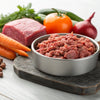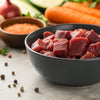What to Add to 80 10 10 Raw Dog Food for Optimal Health
- Houndsy
Table of Contents
- Introduction
- The Basics of the 80 10 10 Raw Dog Food Diet
- Essential Nutrients and How to Supplement Them
- Putting It All Together: Creating the Ultimate 80 10 10 Meal Plan
- Conclusion
Introduction
Did you know that a staggering number of dog owners are unknowingly depriving their pets of critical nutrients? While the raw feeding model of 80 10 10—comprising 80% muscle meat, 10% bone, and 10% organ meat—has gained immense popularity for its natural approach, it often falls short concerning essential dietary requirements. If you're also exploring this raw diet for your furry friend, a pivotal question arises: what should we add to the 80 10 10 raw dog food to ensure our pets are not just surviving but thriving?
Understanding how to supplement this diet is crucial not only for our dogs’ immediate health but also for their long-term well-being. In this blog post, we will delve into the various nutrients commonly lacking in a strict 80 10 10 feeding regimen. From essential fatty acids to vitamins and minerals, we'll guide you on how to balance this feeding model effectively.
By the end, we hope you will feel empowered with actionable insights and a deeper understanding of how to elevate your dog’s daily nutrition, taking a significant step forward in enhancing their overall health and happiness. So, as we explore the subject, we invite you to reflect on your current practices. Are there areas where you could improve your dog’s diet? Let’s dive in!
The Basics of the 80 10 10 Raw Dog Food Diet
The 80 10 10 dietary model serves as a blueprint for replicating the natural diet of wild carnivores, where dogs would consume a variety of prey, including all parts of the animal. However, while this model is a comforting guideline, it can sometimes lead to nutrient deficiencies over time.
Understanding the Composition
-
Muscle Meat (80%): This is the primary source of protein in your dog's diet. Common choices include chicken, beef, lamb, and turkey. Each meat type brings unique characteristics and nutrients.
-
Bone (10%): Providing calcium and other minerals, bones also promote dental health through natural chewing behavior. Soft bones, like chicken necks or wings, are easier to digest.
-
Organs (10%): Organ meats, such as liver and kidneys, are packed with essential vitamins and minerals. However, it's important to know that not all organs are created equal in terms of their nutrient profiles.
Common Gaps in the 80 10 10 Diet
Despite its good intentions, many raw feeders find themselves grappling with one crucial reality: even this relatively balanced diet can leave your pup lacking in specific nutrients. In fact, various studies indicate that raw diets may often lack:
- Omega-3 Fatty Acids
- Vitamins D and E
- Zinc
- Magnesium
- Iodine
- Copper
Let’s take a closer look at each nutrient and what to add to the 80 10 10 mix to avoid deficiencies.
Essential Nutrients and How to Supplement Them
1. Omega-3 Fatty Acids
Omega-3 fatty acids are important for maintaining healthy skin, heart, and brain functions. Unfortunately, an 80 10 10 raw diet usually contains an excess of Omega-6 fatty acids but falls short in Omega-3.
How to Supplement:
- Fatty Fish: Incorporate sources such as sardines, mackerel, or salmon. These fish not only provide Omega-3 but also a flavorful addition to meals.
- Fish Oils: Omega-3-specific supplements like fish oil can be an excellent way to ensure adequate intake.
- Algae Oil: Especially beneficial for vegetarian diets, algae oil is rich in DHA and EPA.
2. Vitamins D and E
Both Vitamin D and E play crucial roles in various body functions, including immune support and skin health. While the sun is a primary source for us, dogs need dietary intake!
How to Supplement:
- Oily Fish: As mentioned, fish such as salmon contain both vitamins, making it a two-in-one supplement.
- Eggs: Another great source of Vitamin D—ideally, use free-range eggs for maximum nutrients. They can also provide a protein boost.
- Seeds and Nuts: Foods like almonds and sunflower seeds are rich in Vitamin E, but be cautious about portion sizes due to their calorie density.
3. Zinc
Zinc supports immune function, cell growth, and reproductive health. In raw diets, it’s often missing due to the lack of organ meat variety.
How to Supplement:
- Pumpkin Seeds: These seeds are a simple, effective way to add zinc. Just a handful per meal can work wonders.
- Oysters: High in zinc, they can be added once a week to provide a nutrient-dense treat.
- Beef or Lamb Liver: While already included partially in the diet, increasing the volume can boost zinc content.
4. Magnesium
Magnesium is essential for several biochemical reactions in the body, including protein synthesis and muscle function.
How to Supplement:
- Leafy Greens: Foods such as spinach or kale can add magnesium while providing fiber.
- Pumpkin Seeds: A repeat here—they’re versatile and packed with nutrients.
- Fish: Oily fish contain magnesium along with other beneficial nutrients.
5. Iodine
Iodine is crucial for thyroid function and metabolic rate. However, it is often overlooked in raw diets.
How to Supplement:
- Seaweed: Dried seaweeds like nori or kelp can be added in small amounts. Not only are they rich in iodine, but they also help to balance other nutrients.
- Fish: Incorporating more fish could also help due to its natural iodine content.
6. Copper
Copper is key for red blood cell production and various enzymatic functions.
How to Supplement:
- Shellfish: Shrimp and mussels are excellent sources of copper.
- Liver: Increasing the amount of organ meat in your dog’s diet scales up copper too.
Other Considerations
In addition to these nutrients, consider adding plant matter to introduce fiber, phytonutrients, and antioxidants. Dark leafy greens, broccoli, carrots, and blueberries can enhance mental acuity and promote gut health.
Putting It All Together: Creating the Ultimate 80 10 10 Meal Plan
After identifying the nutrients and their sources, the next step is to create a comprehensive feeding plan. Start by selecting your dog’s preferred protein sources, then follow the steps below to ensure a balanced diet:
-
Choose Proteins: Select three to five types of meat and rotate them to avoid allergies and promote variety.
-
Include Omega Sources: Whenever possible, add fatty fish or a fish oil supplement twice a week to ensure adequate Omega-3 intake.
-
Incorporate Vegetables: Lightly steam and blend vegetables to aid in digestion. Depending on your dog's size, 10% of meals can include plant matter.
-
Add Organ Meats: Adjust the percentage of organ meats as needed. Aim for the right balance without overwhelming your pup with high-fat organ types like liver.
-
Supplement Nutrients: For known deficiencies, incorporate pumpkin seeds, seaweed, or shellfish based on your dog’s unique needs.
Frequently Asked Questions
Is the 80 10 10 diet suitable for all dogs?
While many dogs thrive on the 80 10 10 model, it may not be suitable for dogs with specific health conditions or dietary restrictions. It’s essential to consult a veterinarian or a canine nutritionist.
How often should I introduce new components into my dog's diet?
Introduce new proteins or plant matter gradually. Monitor your dog’s reaction for signs of allergies or digestive issues.
Can I use commercial supplements with the 80 10 10 diet?
Yes, high-quality supplements can be a beneficial addition, especially for specific vitamins and minerals that may be lacking.
Does Houndsy offer products to enhance the dog feeding experience?
Absolutely! Our flagship product, the Houndsy Kibble Dispenser, is designed to make your dog feeding experience more convenient, clean, and beautiful, ensuring your pet receives balanced nutrition without hassle.
Conclusion
The 80 10 10 raw dog food diet is an excellent starting point, but its effectiveness relies heavily on our ability to supplement it appropriately. By adding variety in proteins, essential fatty acids, vitamins, minerals, and even wholesome plant matter, we can create a robust nutritional foundation that not only fulfills our dogs' basic needs but also elevates their overall health.
Taking the time to reflect on what our pets require from their diets can yield significant results. At Houndsy, we are passionate about enhancing the pet feeding experience with innovative designs like the Houndsy Kibble Dispenser, allowing for healthier feeding practices. Ask yourself: how can you adjust your dog’s meal plan today for a happier, healthier tomorrow?
We hope this guide empowers you to formulate the optimal 80 10 10 raw diet for your furry friend. Your commitment to their health means everything!












